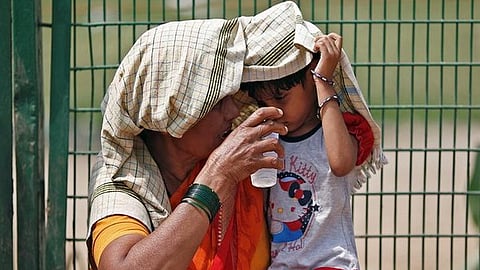

NEW DELHI: In India, 57 per cent of districts, which are home to 76 per cent of the population, are at very high risk of extreme heat.
This heat-affected population is experiencing alarmingly warm nights, increasing relative humidity, and heat island effects in densely populated urban areas.
A study conducted by the Delhi-based research organisation Council on Energy, Environment and Water (CEEW) analysed that traditionally drier northern Indian cities are experiencing higher levels of humidity and warmer nights, impacting the health of a large population.
The study ‘How Extreme Heat is Impacting India: Assessing District-level Heat Risk’ has mapped heat risk assessments of 734 districts in India using 35 indicators. It provides detailed insight into how climate change has influenced heat hazard trends from 1982 to 2022.
It has used indicators including hazard, exposure, and vulnerability. In addition, it has analysed night-time heat and relative humidity to measure how climate change has altered the frequency, intensity, and duration of heat hazards in the past four decades.
According to the study, 417 districts fell into the high and very high risk categories of extreme heat, while 201 were classified as moderate risk categories. Meanwhile, the remaining 116 districts are relatively less exposed to extreme heat.
The study highlights key trends, such as the rise in warm nights across the country, the increase in relative humidity across North India, particularly in the Indo-Gangetic Plain, and heightened heat exposure in dense, urban, and economically critical districts such as Delhi, Mumbai, Ahmedabad, Hyderabad, Bhopal, and Bhubaneswar.
Further, some rural districts in Maharashtra, Kerala, Uttar Pradesh, and Bihar—home to large numbers of agricultural outdoor workers—were also found to fall in the high to very high heat risk category.
Further, the study analysed that 70 per cent of districts have seen more than five additional very warm nights per summer over the past decade (2012-2022) compared to the climatic baseline (1982-2011).
Very warm nights are defined as nights when the temperature stays unusually high, warmer than what used to be normal 95 per cent of the time. Warmer nights make it harder for the human body to cool down and recover from daytime heat.
The study also finds increased relative humidity by up to 10% across the Indo-Gangetic Plains over the last decade. Historically, North India experienced 30-40% humidity, which increased to 40-50%. It further underlines that traditionally drier cities such as Delhi, Chandigarh, Kanpur, Jaipur, and Varanasi now see higher humidity levels.
Sweating is the primary cooling mechanism when body temperature exceeds 37°C, but high humidity hinders evaporation.
“Heat stress is no longer a future threat—it’s a present reality,” said Dr Arunabha Ghose, CEO, CEEW. “We are entering an era of intense, prolonged heat, rising humidity, and dangerously warm nights,” he said.